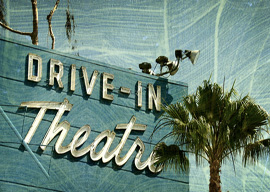
August 24, 2012

The studios have been warning this time would come for a while. It costs around $2,000 to make a 35mm print, while sending a digital file is as easy as mailing a $100 hard drive. Soon it will be as simple as transmitting it through the Web for free. Having the drive-ins pay the $2,000 themselves seems like a solution, but at the $8 per ticket or so that small drive-ins charge, that’s 250 customers merely to recoup the cost of the print. Playing old movies seems like another option, but those movies don”t exist for the most part. The studios usually burn old copies of films and the few that remain are so deteriorated they”re unwatchable. Besides, most people don”t want to go to the drive-in to see an old print of American Graffiti. They want to see the blockbuster that came out an hour ago.
One compromise the studios have come up with is to offer theaters some of the savings made from not printing celluloid. They”re called Virtual Print Fees. The way it works is that every time a theater takes a first-run movie, the studio pays off a little bit of their projector debt. The contract comes with a lot of strings, including a pricey servicing fee to maintain the equipment, plus the studio gets to decide which movies you can show on “your” new digital projector. You”re also only eligible for these fees if you get a first-run movie out of the gate. Theaters that take films more than a month old are not eligible. It’s a lopsided agreement reminiscent of the “360 deal“ that record labels came up with to make their money back after Napster.
What’s worse, drive-ins have to deal with ambient light and much larger screens, so the projector’s quality has to be much higher than that of normal theaters. If the theater doesn”t meet industry standards”meaning it’s not compliant with Digital Cinema Initiatives (DCI) requirements”it won”t get to show the movies.
What’s even worse, drive-ins have a very short season in most climates and even that is cut short by how crappy movies become in September. (Why is that, by the way?)
What’s way worser is that it’s almost impossible for drive-ins to get loans. Banks aren”t interested in your collateral when it’s likely they”ll be left with a rotting screen in a concrete field.
What’s even worsest is that in the past, most small businesses had been using their houses as collateral to get through tough times. Today most homes are worth less than they were five years ago, so using them to finance loans isn”t even an option.
None of this doom and gloom even matters, however. The big picture is that a digital projector costs more than most drive-ins seem to net for an entire year. Some have ignored the numbers and tried the conversion anyway. The first drive-in to go digital in the whole country was the Spud Drive-In of Diggs, Idaho. They went bankrupt soon after and have recently reopened using an old analog projector.
This is what life is like in the real economy. You build something with your own two hands but you”re still at the market’s mercy. Javener estimates that about 80% of theaters have converted to digital, but that mostly includes big theaters or VPF deals. The remaining 20% are the little guys, including most drive-ins. But like all good entrepreneurs, he has some tricks up his sleeve. He may have to close down his drive-in at first but as others collapse, they will have to sell their digital projectors at a reduced price. It will be a struggle but if there is a way to continue the drive-in, he will find it. When that happens, he”ll be able to look at his refurbished creation and say, “I built that”again.”
Image courtesy of Shutterstock